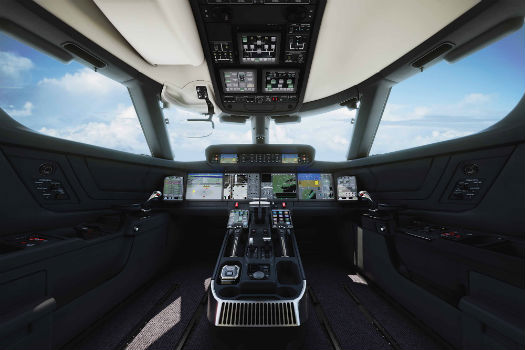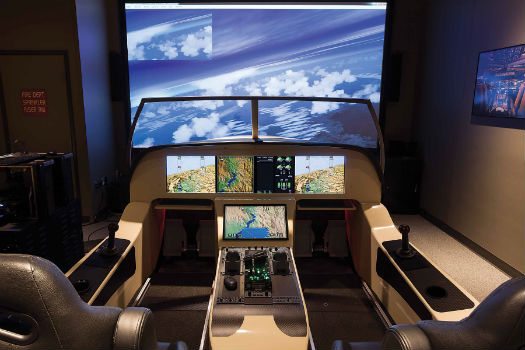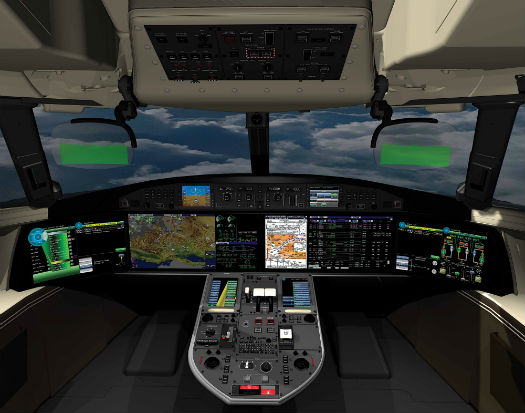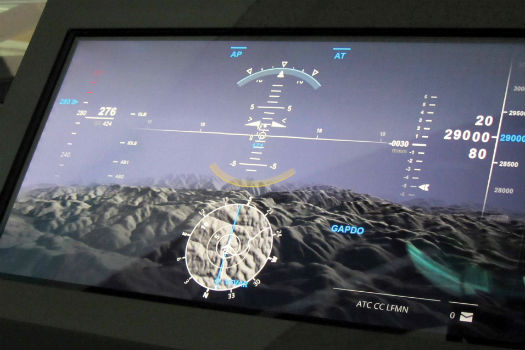The Gulfstream G500 and G600 will feature active sidesticks. Gulfstream Photo
The big three avionics manufacturers—Honeywell, Rockwell Collins and Thales—are quietly preparing the flight decks of tomorrow’s airliners, making the most of recent progress in the understanding of the human brain. Some major improvements are coming from the business aviation world, where missions are often more complex and the flight plan can be changed in flight. These innovations include the front-panel touchscreen, the head-up display (HUD) and the active sidestick.
Honeywell engineers say research indicates that some tasks are better suited to graphical thinking, while others are more suited to text. Jay Beckman Photo
Thales’ demonstrator focuses on pilot anticipation
Thales already has a demonstrator. The entirely new human-machine interface is dubbed Avionics 2020. Based on a set of large touchscreens, it is being designed to offer more intuitive interaction. It therefore aims at better situational awareness and easier decision-making.
It is scalable to any type of aircraft, including helicopters, according to Thales. On the airliner layout, four displays are located on the front panel and the other two are on the pedestal. An Avionics 2020-based flight deck could enter into service early in the next decade, as its name suggests.
“Current cockpit architecture is fast reaching the limit of the amount of systems that can be efficiently operated by pilots. The next generation of cockpit will require a different approach,” according to information prepared by Thales. Avionics 2020 is the result of a number of partnerships spearheaded by Thales and involves in-depth research into the understanding of the interface. The demonstrator follows the principles of “natural and direct hands-on interaction,” as Thales’ experts put it.
Avionics 2020 helps pilots “capitalize on their strengths and manage their weaknesses.” Decision-making is therefore “instinctive and less reliant on cognitive analysis.” Thales’ experts explain that this mimics the process the human brain goes through to make a decision, especially under stress. In practice, touchscreens make it more straightforward to prepare a flight or to change destination after departure.
Thales’ Avionics 2020 human-machine interface incorporates everyday gestures, such as pinch and zoom. Philippe Coni Photo
One design driver is helping the pilot to anticipate the next stage of the flight. This can be done via the “timeline,” a graphic depiction of the trip’s successive events. On the timeline, the pilot can zoom in and see the upcoming changes—waypoints, altitude, aircraft configuration, etc.
The new flight deck is supposed to give the pilot a clear image of the actions he or she chooses to delegate. When assigning the autopilot to capture a heading, the pursued heading will be shown in blue on the main display. This also helps answer the question, “What is the system doing and what is it going to do next?”
The third design driver has been schematization. The idea is to avoid excessively complex views of the systems. When a problem arises, the pilot will first be given a broad picture to show them where the issue is on the aircraft. Then, he or she can—by a single touch input—enter a more detailed level of representation.The fourth design driver has been to make learning curves as swift as possible. A new interaction must quickly become a routine, thus freeing up the pilot’s mind. Thales engineers have copied everyday life protocols, such as the pinch-to-zoom gesture. An easy method is considered preferable in a stress situation.
This also translates into straightforward actions and views. When selecting an airport on the moving map, the pilot can add the radio frequency to the related list on the communications display. The pilot will see the radio frequency sliding through the displays, from the map to its position on the list. This not only looks nice—it uses cognitive continuity which, Thales experts say, is a very powerful way to save mental resources.
Intuitiveness can also be found with throttle positions. The “eco climb” position is displayed above the horizon line and the “climb” position even higher, while the “idle” position is displayed below the horizon. This gives an immediate depiction of the consequence of moving the throttle.
Moreover, as an input, these throttle positions can be seen on the left part of the screen. Meanwhile, the output—the vertical speed—is shown on the right part. This layout makes the relationship between the input and the output obvious.
From a technology standpoint, Thales claims to have brought cockpit touchscreens to an “iPhone-like” user experience. For instance, the pilot can drag and drop an object continuously through flush displays. “A cockpit designed around more seamless interaction between the pilot and the electronics is no longer a purely intellectual concept, but a viable commercial application,” said Denis Bonnet, head of innovation for Thales’ cockpit competence centre.
According to Rockwell Collins (here a conceptual image), large displays help pilots to process information and assemble the big picture. Rockwell Collins Photo
Heads up
On Avionics 2020, bi-chromal HUDs are available, too. The second colour—red, in addition to the conventional green—could help with alert messages. Generally speaking, HUDs are relatively new to commercial passenger aircraft. They are more widespread in business aircraft. The latter tend to fly to small airports where navigation aids, such as ILS, are not as sophisticated as at large airports. This was one of the main reasons why HUDs, which can display a synthetic view of the runway, first became popular on business jets.
Other benefits are enjoyable for all pilots. A HUD allows the pilot to read critical information while looking at the outside world. Hence, there is a better situational awareness. Some HUDs offer enhanced vision (EVS, thanks to infrared sensors) or synthetic vision (SVS, where a database and GPS provide terrain images).
Two HUDs are standard on the Boeing 787 Dreamliner. One single HUD is an option on the Boeing 737 MAX and dual HUD is optional on the 777X. Airbus’ designers, whose philosophy has long favoured automation, seem to have converted to HUDs. The A350 XWB thus offers one optional HUD.
According to Matt Carrico, Rockwell Collins’ senior engineering manager and fellow, advanced concepts, the flightpath vector on a HUD gives a clear idea on where the aircraft is going—the symbol relates to the outside world. His company has made SVS available to the HUD as another selectable overlay.
“We are investigating combined visions systems (CVS), the combined display of SVS and EVS,” added Carrico. In a CVS, the system determines which source (EVS or SVS) has better info, thanks to sophisticated image processing. The Dassault Falcon 5X and 8X business jets will be the first aircraft to feature a CVS HUD, designed with Elbit Systems.
Thales engineers use colour coding to help Avionics 2020 users understand what the system is doing. Thales Photo
Honeywell, Rockwell Collins build on large displays
In the head-down part of the instrument panel, we will see larger displays. “The current 15-inch standard is here for years to come,” Carrico believes. A decade ago, there was hope for organic light-emitting diodes (OLED) to fill up the entire forward space. However, today’s OLED technology is far from the aviation industry’s expectation for a 20-year lifetime. If used in sun-readable conditions, an image-retention phenomenon may happen in the long run—a problem similar to that encountered with old cathode ray tube displays.
Large displays are “a simple way for the pilot to assemble the elements,” said Carrico. They offer feature-rich visualization and topology maps. With old “steam gauge” style cockpits, pilots had to do a lot of mental gymnastics to form an image in their mind. The trend is building, as overlays (such as a weather chart) eliminate the need to look at two or three different displays.
Aaron Gannon, a Honeywell scientist for advanced technology, explains it in terms of communicating to the right part of the brain. “Thanks to graphic displays, we can connect directly to the visual cortex, located at the back of your head,” he said.
Some tasks are better suited to think graphically, while others are rather suited to text. “We know that better thanks to our work in cognitive sciences,” added Bill Rogers, Honeywell’s engineering senior fellow, advanced technology.
With larger displays and better organization, additional information could be put up front more effectively. Less information would be buried in menus, and the pilot would not need to remember where a piece of information is located, as they used to do with old cockpit layouts.
But replacing two displays with a larger one has drawbacks. “Discrete displays provide redundancy,” emphasized Doug Harris, Honeywell’s senior manager, technical hardware, advanced technology. His team is looking at technologies that could provide redundancy on a single display.
Honeywell engineers are testing all sorts of interfaces, including hand gestures, but believe some hard controls will remain as quick-action enablers. Jay Beckman Photo
Touchscreens versus hard controls
Are touchscreens really the next big move? Again, business aviation is at the forefront of the trend. For example, Rockwell Collins is to certify, over the coming months, a cockpit upgrade for the King Air line of turboprops. The Pro Line Fusion Touch avionics suite uses touchscreens for primary and multifunction displays (PFD, MFD).
“It has large, easy-to-select features, a hand anchor and the distance between the pilot’s shoulder and the screen is reasonable,” commented Rockwell Collins’ Carrico. The touch interface is often much faster than conventional controls or even a cursor-control device (CCD). This can be felt especially for otherwise-complex system management and navigation tasks.
Nevertheless, the crew may use an alternative hard control on the pedestal. This will probably be only for medium to strong turbulence. Using the touchscreen in light turbulence is fine, according to Carrico. The Pro Line Fusion Touch upgrade may not be as advanced as Thales’ demonstrator, but it will be one of the very first certified avionics suites using touchscreens for PFDs and MFDs.
Honeywell’s specialists, too, are embracing touchscreens but are taking a cautious approach to their design choices. “There are at least a dozen different touchscreen technologies. One can be better in terms of force feedback (to avoid inadvertent touch) while the other one is better against electromagnetic interference,” said Honeywell’s Harris. In future, a touchscreen could even provide haptic feedback. There are tradeoffs with each. “We are working on technologies to mitigate the issues caused by fingerprints, such as reduced sunlight viewability,” he added.
Honeywell has a full-motion flight simulator where experts evaluate touchscreens, among other man-machine interfaces, in various locations—overhead, front, pedestal, etc. “We measure control accuracy and other aspects of performance,” continued Harris.
Honeywell has a full-motion flight simulator where experts evaluate touchscreens, among other man-made interfaces. Jay Beckman Photo
Hard controls like push buttons, however, are unlikely to disappear. “We want to use some controls quickly,” commented Rockwell Collins’ Carrico. Hence the need for a hard, one-action control. The need is driven by the criticality of the action but mainly by the frequency of use. “An example is the landing lights. During taxi, the crew does not even want to look at the display to find the lights’ control, they do not want to lose that muscle memory,” Carrico stressed. Therefore, Rockwell Collins will not integrate everything into touchscreens or CCDs and will keep some push buttons and rotating knobs.
The third design feature business aviation seems to be pioneering is the active sidestick for fly-by-wire controls. Airbus, the first commercial aircraft manufacturer to have introduced sidesticks, has long despised active versions as useless sophistication. Yet, the in-development Gulfstream G500 and G600 large-cabin business jets will feature active sidesticks.
Supplied by BAE Systems, the active sidesticks not only move in concert, but also provide force feedback to inform each crewmember about what the other one is doing. “This will help crew coordination,” Carrico noted.
The question now is to see which commercial passenger manufacturer will be the first to be inspired by Gulfstream’s move.













